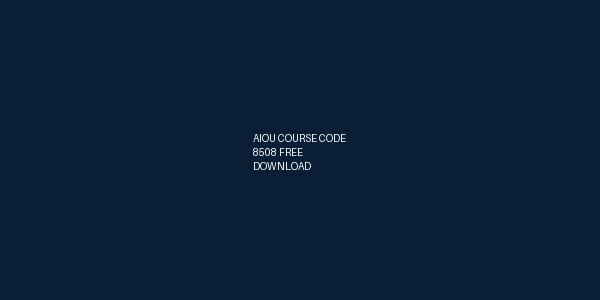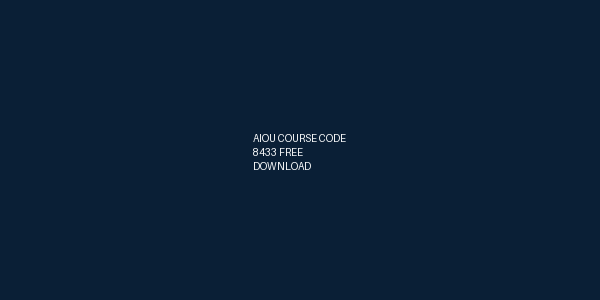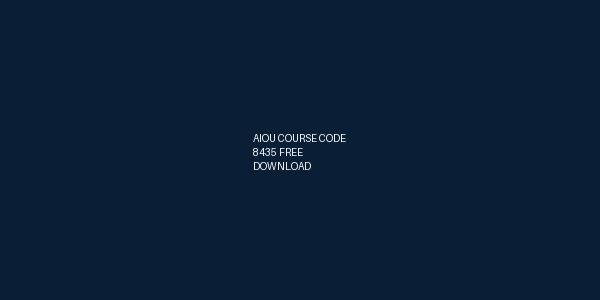AIOU Course Code 8508 Free Download

ALLAMA IQBAL OPEN UNIVERSITY, ISLAMABAD
(Department of Commerce)
MANAGERIAL ACCOUNTING (8508)
CHECKLIST
SEMESTER SPRING 2025
This packet comprises the following material:
- Text Book (ONE)
- Course Outline
- Assignment No. 1,2
- Assignment Forms (2sets)
In this packet, if you find anything missing from the above-mentioned material, please contact us at the address given below:
Mailing Officer
Allama Iqbal Open University
H-8, Islamabad
Ph: 051-9057611-12
Dr. Muhammad Munir Ahmad
(Course Coordinator)
ALLAMA IQBAL OPEN UNIVERSITY, ISLAMABAD
(Department of Commerce)
[
WARNING
- PLAGIARISM OR HIRING OF GHOST WRITER(S) FOR SOLVING THE ASSIGNMENT(S) WILL DEBAR THE STUDENT FROM THE AWARD OF DEGREE/CERTIFICATE IF FOUND AT ANY STAGE.
- SUBMITTING ASSIGNMENTS BORROWED OR STOLEN FROM OTHER(S) AS ONE’S OWN WILL BE PENALIZED AS DEFINED IN THE “AIOU PLAGIARISM POLICY”.
Course: Managerial Accounting (8508) Semester: Spring 2025
Level: MBA
Please read the following instructions for writing your assignments. (AD, BS, B. Ed, MA/MSc, MEd) (ODL Mode).
1. All questions are compulsory and carry equal marks but within a question the marks are distributed according to its requirements.
2. Read the question carefully and then answer it according to the requirements of the questions.
3. Avoid irrelevant discussion/information and reproducing from books, study guide or allied material.
4. Handwritten scanned assignments are not acceptable.
5. Upload your typed (in Word or PDF format) assignments on or before the due date.
6. Your own analysis and synthesis will be appreciated.
7. Late assignments can’t be uploaded at LMS.
8. The students who attempt their assignments in Urdu/Arabic may upload a scanned copy of their handwritten assignments (in PDF format) on University LMS. The size of the file should not exceed 5MB.
Total Marks: 100 Pass Marks: 50
ASSIGNMENT No. 1
Question No 1 Marks = (20)
Describe the following cost terms frequently used by managerial accountants with suitable example/s:
a) Direct cost. b) Marginal cost.
c) Semi-variable cost. d) Relevant cost
e) Incremental cost f) product cost
g) Period cost. h) Non-manufacturing cost.
i) Opportunity cost. j) Imputed cost.
Question No 2 Marks = (20)
Tasty Food Enterprises had the following inventories on 1 March 2023:
Materials Rs. 26,000 Finished Goods Rs. 28,000 Work in process Rs. 30,000
The work-in-process account contains the following jobs:
Job 951 | Job 956 | Job 975 | |
Materials | Rs. 2800 | 3,800 | 5,000 |
Labor | Rs. 2100 | 3,500 | 4,000 |
Factory overhead applied | Rs. 1700 | 1,900 | 4,200 |
Total | Rs. 6600 | 9,200 | 13,200 |
The following transactions were undertaken during March 2023
Required
Question No 3 Marks = (20)
Good Fit Industries produces various kinds of garments in a joint process. The data relating to the production of various garments is as under.
Products | Units |
Shirts | 5,000 |
Trousers | 4,000 |
Caps | 3,000 |
These garments are produced in a common manufacturing process. The raw material is used in the ratio of 2:2.5:1, the labour cost is spent in the ratio of 1.5:1:0.5 while the overhead cost is availed by each product in the quantum of 1:1: 0.5. The joint cost incurred during the month was as under.
Raw material | Rs 300,000 |
Direct labour | Rs. 250,000 |
Overheads | Rs. 150,000 |
Required:
Work out the cost allocation of material, labor and overheads to each joint product and also the total cost of each category of product unit.
Question No 4 Marks = (20)
- The record of the Good-Fit Garments Industry indicates that the average daily requirement of cloth is 50 Meters. The maximum monthly requirement of cloth is 2,500 Meters while the minimum requirement during any month is not likely to fall below 1,000 Meters. The lead time is 15 days. The Economic Order Quantity is 1,200 Meters. The lead time for emergency supplies is 3 days. Required: Compute the following cloth inventories which should be maintained: (A) Ordering level (B) Minimum level (C) Maximum level (D) Danger level
Cost of Goods Sold Income before taxes | Rs. 3,700,000 250,000 |
Income tax expense | 105,000 |
Net income | 145,000 |
The destiny of the financial statement for the year 2023 revealed that had the company been applying the FIFO inventory costing method, its cost of goods sold would have been at Rs. 3,730,000. The rate of income tax applicable to the company is 40% of income before tax.
Required:
1) Income before taxes 2) Income tax expense 3) Net Income after tax.
Question No 5 Marks = (20)
Grown manufactures and sells pens. Present sales output is 5 million annually at a selling price of Rs. 0.50 per unit. Fixed costs are Rs. 900,000 per year. Variable costs are Rs. 0.30 perunit.
Required (Consider each case separately.)
Total Marks: 100 Pass Marks: 50
Question No 1
What is a master budget? What is the normal starting point in developing the master
Budget.
The marketing department of Jessi Corporation has submitted the following sales forecast
for the upcoming fiscal year (all sales are on account): (Marks =20)
1st Quarter 2nd Quarter 3rd Quarter 4th Quarter
Budgeted unit sales .............. 11,000 12,000 14,000 13,000
The selling price of the company’s product is Rs.20.00 per unit. Management expects to collect 70% of sales in the quarter in which the sales are made, 20% in the following quarter, and 10% of sales are expected to be uncollectible. The beginning balance of accounts receivable, all of which, is expected to be collected in the first quarter, is Rs.70,200.
The company expects to start the first quarter with 1,650 units in finished goods inventory. Management desires an ending finished goods inventory in each quarter equal to 15% of the next quarter’s budgeted sales. The desired ending finished goods inventory for the fourth quarter is 1,850 units.
Required:
1. Prepare the company’s sales budget and schedule of expected cash collections.
2. Prepare the company’s production budget for the upcoming fiscal year.
Question No 2
Excel Toys Industry manufactures plastic toys with the following material and labour standards: Marks = (20)
Standard quantity | Standard cost | |
Material | 0.2 kg | Rs. 60 per kg |
Labour | 12 minutes | Rs. 200 per labour hour |
Variable overheads | Labour base time | Rs. 150 per labour hour |
During the month of January 24,000 kg of material was procured on account at Rs. 50 per kg. During January 14,400 kgs of the material was used in the production of 80,000 toys. The payroll for January indicates 16,500 direct labour hours at a total cost of Rs. 3,135,000. The variable overheads amounted to Rs. 1,947,000 during the month of January.
Required
a. Compute material price and material quantity variances for the month of January.
b. Compute the labour rate and the labour efficiency variance for the month of January.
c. Work out the overheadoverhead rate and efficiency variance for the month of January.
d. Based on the above variances evaluate the performance of the concerned manager responsible.
e. Assuming that the perpetual inventory and standard cost accounting system is being used, prepare relevant general journal entries for the above transactions including variances in the books of accounts of the company.
Question No 3
The Standard Manufacturing Company is producing room chairs for domestic use. The opening inventory of chairs of 500 units had a cost of Rs. 455 per chair under absorption costing. During the year it produced 12,500 chairs and sold 10,000 chairs. The manufacturing cost consisted of Rs. 130 for direct material, Rs. 120 for direct labour and variable overheads amounted to Rs. 80 per chair. The fixed overheads were Rs. 1,562,500 per annum. The production volume and cost structure have remained constant throughout the last and current years. The sale price per chair was Rs. 650. The variable selling expenses were Rs. 25 per unit and fixed selling and administrative expenses were Rs. 800,000 per annum. Marks = (20)
Required
a. Prepare income statement under absorption costing for the year.
b. Prepare income statement under variable costing for the year.
c. Prepare a reconciliation statement of the net income as reported under absorption costing with the variable costing.
d. Which of the income statements should be used by the management for external reporting purposes? Support your recommendations with appropriate arguments.
Question No 4 Marks = (20)
XY provides accountancy services and has three different categories of clients: limited companies, self-employed individuals, and employed individuals requiring taxation advice. XY currently charges its clients a fee by adding a 20% mark-up to total costs. Currently, the costs are attributed to each client based on the hours spent on preparing accounts and providing advice.
XY is considering changing to an activity-based costing system. The annual costs and the causes of these costs have been analyzed as follows:
Accounts preparation and advice Requesting missing information Issuing fee payment reminders Holding client meetings Travelling to clients | Rs. 580000 30000 15000 60000 40000 |
The following details relate to three of XY’s clients and XY as a whole:
PARTICULARS | Clients | XY | ||
A | B | C | ||
Hours spent on preparing accounts and providing advice | 1000 | 250 | 340 | 18000 |
Requests for missing information | 4 | 10 | 6 | 250 |
Payment reminders sent | 2 | 8 | 10 | 400 |
Client meetings held | 4 | 1 | 2 | 250 |
Miles travelled to meet clients | 150 | 600 | 0 | 10000 |
Required: Prepare calculations to show the effect on fees charged to each of these three clients of changing to the new costing system.
Question No 5 Marks = (20)
What are the objectives of profitability planning by the management? What practical benefits can be attained by the management from profitability planning?

